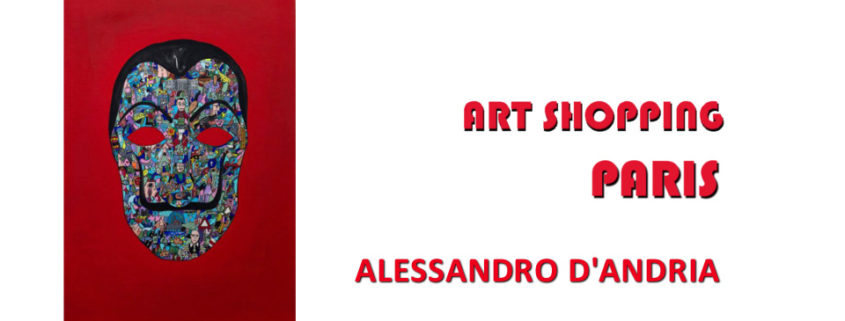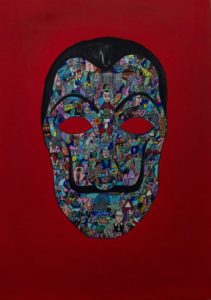Alessandro D’Andria – Art Shopping Paris 2018
Art Shopping Paris
19 – 21 ottobre 2018
Parigi – Carrousel du Louvre
Stand D89 e D90
Il Melograno Art Gallery
L’artista Alessandro D’Andria, nato a Salerno nel 1989, si diploma nel 2008 nel liceo Artistico della sua città dove sin da subito capisce ciò che l’aiuterà ad esprimersi per modi dei suoi anni. Questo giovane artista si sta incamminando in un percorso di ricerca artistica pura: lo sviluppo di un linguaggio personale in cui colpito dal genio indiscusso di Salvador Dalì e dal graffitismo metropolitano di Keith Haring inizia a fantasticare su fogli e tele.
Alessandro ha molto da raccontare con colore e rappresentazioni non convenzionali che lo portano a dare una lettura nuova e uno sguardo “polemico” verso una cultura dalla quale non si sente rappresentato.
Nella prima fase le sue opere sono molto confusionali ed intrecciate formate da colori molto vivi, piccoli disegni, elementi e tratti infantili che ipnotizzano lo spettatore.
L’obiettivo principale è quello di creare qualcosa di onirico e contestualizzarlo in ambito reale.
Tutti gli elementi, le figure, etc. sono rappresentate quasi in maniera claustrofobica per dar vita ad un unico soggetto.
Nella seconda fase l’artista si rifà all’interpretazione personale della sua vita, per la sua ricerca pittorica dove indaga e sperimenta una visione molto personale del “Degrado “ che lo circonda.
Le tele si ingrandiscono e i soggetti diventano singoli superando quella fase del “nascondere” influenzato dalle letture di Charles Bukowski.
Quest’ultimo, maggior esponente del “realismo sporco”, riesce a dare voce a quello che Alessandro cercava di rappresentare.
Lo scopo rimane quello di raccontare la vita in maniera cruda sotto tanti punti di vista, ma nello stesso tempo creare un diversivo che possa rendere più leggera e piacevole la visione.
Chi si trova dinnanzi le tele del giovane artista ha un senso di imbarazzo nell’osservare la sfrontatezza con cui egli mette su tela i più piccoli dettagli degli organi sessuali, i colori improponibili o le forme eccessive dei seni o la naturalezza con il quale trasforma i più banali animali nelle metamorfosi umane, da cui per l’Artista semplicemente un sinuoso corpo femminile si tramuta in gambero o pesce rosso.
Alessandro D’Andria, born in Salerno in 1989, graduated in 2008 in the high school of his city where he immediately understands what will help him to express himself for the ways of his years. This young artist is moving on a path of pure artistic research: the development of a personal language in which impressed by the undisputed genius of Salvador Dali and the metropolitan graffiti of Keith Haring begins to fantasize on sheets and canvases.
Alessandro has a lot to tell with color and unconventional representations that lead him to give a new reading and a “polemical” look towards a culture from which he does not feel represented.
In the first phase his works are very confusing and interwoven, formed by very vivid colors, small drawings, elements and infantile features that hypnotize the viewer.
The main objective is to create something dreamlike and contextualize it in the real world.
All the elements, the figures, etc. they are represented almost in a claustrophobic manner to give life to a single subject.
In the second phase the artist recalls the personal interpretation of his life, for his pictorial research where he investigates and experiments a very personal vision of the “Degrado” that surrounds him.
The canvases are enlarged and the subjects become single, overcoming that phase of “hiding” influenced by the readings of Charles Bukowski.
Bukowski, the greatest exponent of “dirty realism”, manages to give voice to what Alexander tried to represent.
The aim is to tell life in a raw way under many points of view, but at the same time create a diversion to make the visione lighter and pleasant
Those who find themselves before the canvases of the young artist have a sense of embarrassment in observing the boldness with which he puts on the canvas the smallest details of the sexual organs, the impractical colors or the excessive forms of the breasts or the naturalness with which he transforms more banal animals in human metamorphoses, from which for the Artist a sinuous female body simply turns into shrimp or goldfish.





